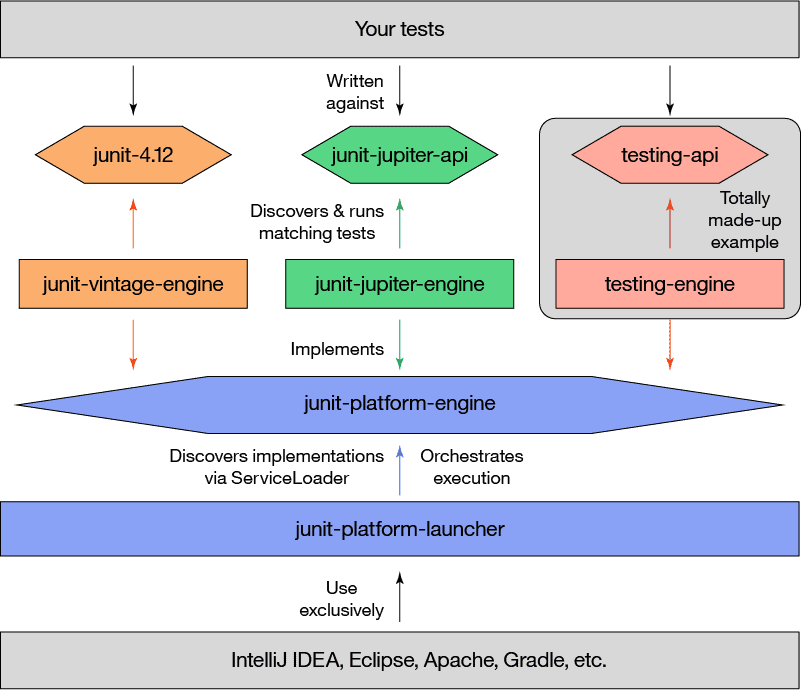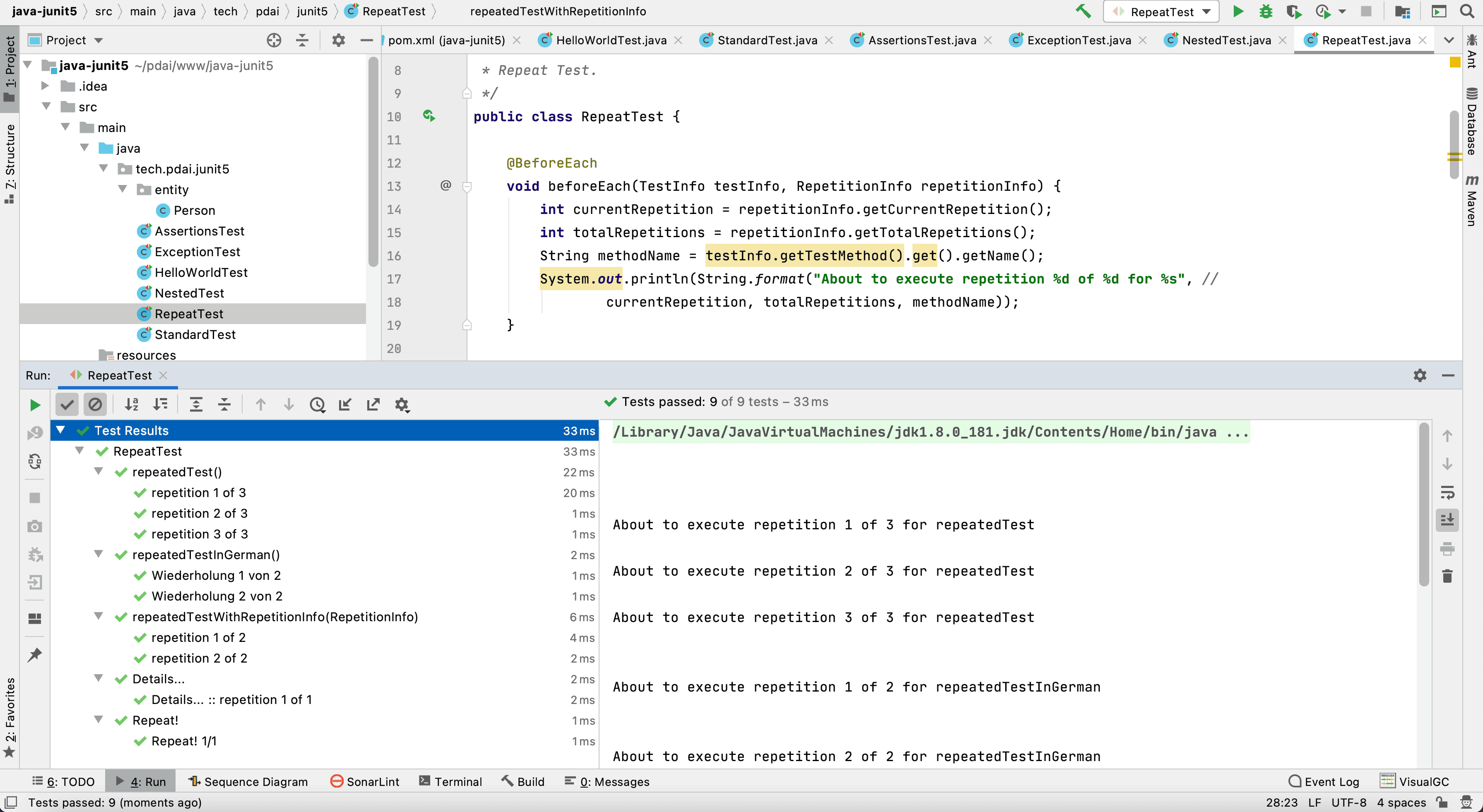Junit5 详解
Junit5 详解
JUnit 5是JUnit的下一代。目标是为JVM上的开发人员端测试创建一个最新的基础。这包括专注于Java 8及更高版本,以及启用许多不同风格的测试。
官方资料
最好的资料依然在Junit官方网站,以下我帮你总结下Junit相关的官方网址。
- 官网地址
- 官方入门文档
https://junit.org/junit5/docs/current/user-guide/#overview
- 官方例子
https://github.com/junit-team/junit5-samples
- 官方github
Junit5的架构
与以前版本的JUnit不同,JUnit 5由三个不同子项目中的几个不同模块组成。
JUnit 5 = JUnit Platform + JUnit Jupiter + JUnit Vintage
- JUnit Platform是基于JVM的运行测试的基础框架在,它定义了开发运行在这个测试框架上的TestEngine API。此外该平台提供了一个控制台启动器,可以从命令行启动平台,可以为Gradle和 Maven构建插件,同时提供基于JUnit 4的Runner。
- JUnit Jupiter是在JUnit 5中编写测试和扩展的新编程模型和扩展模型的组合.Jupiter子项目提供了一个TestEngine在平台上运行基于Jupiter的测试。
- JUnit Vintage提供了一个TestEngine在平台上运行基于JUnit 3和JUnit 4的测试。
架构图如下:

JUnit Jupiter API 的使用
JUnit Jupiter是在JUnit 5中编写测试和扩展的新编程模型和扩展模型的组合; 所以我们使用Jupiter来学习Junit5。
常用注解
@Test 表示方法是一种测试方法。 与JUnit 4的@Test注解不同,此注释不会声明任何属性。
@ParameterizedTest 表示方法是参数化测试
@RepeatedTest 表示方法是重复测试模板
@TestFactory 表示方法是动态测试的测试工程
@DisplayName 为测试类或者测试方法自定义一个名称
@BeforeEach 表示方法在每个测试方法运行前都会运行 ,@AfterEach 表示方法在每个测试方法运行之后都会运行
@BeforeAll 表示方法在所有测试方法之前运行 ,@AfterAll 表示方法在所有测试方法之后运行
@Nested 表示带注解的类是嵌套的非静态测试类,@BeforeAll和 @AfterAll方法不能直接在@Nested测试类中使用,除非修改测试实例生命周期。
@Tag 用于在类或方法级别声明用于过滤测试的标记
@Disabled 用于禁用测试类或测试方法
@ExtendWith 用于注册自定义扩展,该注解可以继承
@FixMethodOrder(MethodSorters.NAME_ASCENDING),控制测试类中方法执行的顺序,这种测试方式将按方法名称的进行排序,由于是按字符的字典顺序,所以以这种方式指定执行顺序会始终保持一致;不过这种方式需要对测试方法有一定的命名规则,如 测试方法均以testNNN开头(NNN表示测试方法序列号 001-999)
编写单元测试
接下来,我们开始学习JUnit5单元测试实例:
Maven包引入
最新的包引入,请参考这里:https://junit.org/junit5/docs/current/user-guide/#running-tests
<?xml version="1.0" encoding="UTF-8"?>
<project xmlns="http://maven.apache.org/POM/4.0.0"
xmlns:xsi="http://www.w3.org/2001/XMLSchema-instance"
xsi:schemaLocation="http://maven.apache.org/POM/4.0.0 http://maven.apache.org/xsd/maven-4.0.0.xsd">
<modelVersion>4.0.0</modelVersion>
<groupId>com.gavin.james</groupId>
<artifactId>java-junit5</artifactId>
<version>1.0-SNAPSHOT</version>
<dependencies>
<!-- Only needed to run tests in a version of IntelliJ IDEA that bundles older versions -->
<dependency>
<groupId>org.junit.platform</groupId>
<artifactId>junit-platform-launcher</artifactId>
<version>1.7.0</version>
<scope>test</scope>
</dependency>
<dependency>
<groupId>org.junit.jupiter</groupId>
<artifactId>junit-jupiter-engine</artifactId>
<version>5.7.0</version>
<scope>test</scope>
</dependency>
<dependency>
<groupId>org.junit.vintage</groupId>
<artifactId>junit-vintage-engine</artifactId>
<version>5.7.0</version>
<scope>test</scope>
</dependency>
<dependency>
<groupId>org.junit.jupiter</groupId>
<artifactId>junit-jupiter-api</artifactId>
<version>5.7.0</version>
</dependency>
<!-- lombok -->
<dependency>
<groupId>org.projectlombok</groupId>
<artifactId>lombok</artifactId>
<version>1.18.16</version>
</dependency>
</dependencies>
</project>
测试:Hello World
第一个测试:
package com.gavin.james.junit5;
import org.junit.jupiter.api.Test;
import static org.junit.jupiter.api.Assertions.assertEquals;
/**
* Hello world test.
*
* @author
*/
public class HelloWorldTest {
@Test
void firstTest() {
assertEquals(2, 1 + 1);
}
}
执行结果

@Test注解在方法上标记方法为测试方法,以便构建工具和 IDE 能够识别并执行它们。JUnit 5不再需要手动将测试类与测试方法为public,包可见的访问级别就足够了。
测试:生命周期
首先,需要对比下Junit5和Junit4注解:
| Junit4 | Junit5 | 注释 |
|---|---|---|
| @Test | @Test | 表示该方法是一个测试方法 |
| @BeforeClass | @BeforeAll | 表示使用了该注解的方法应该在当前类中所有测试方法之前执行(只执行一次),并且它必须是 static方法(除非@TestInstance指定生命周期为Lifecycle.PER_CLASS) |
| @AfterClass | @AfterAll | 表示使用了该注解的方法应该在当前类中所有测试方法之后执行(只执行一次),并且它必须是 static方法(除非@TestInstance指定生命周期为Lifecycle.PER_CLASS) |
| @Before | @BeforeEach | 表示使用了该注解的方法应该在当前类中每一个测试方法之前执行 |
| @After | @AfterEach | 表示使用了该注解的方法应该在当前类中每一个测试方法之后执行 |
| @Ignore | @Disabled | 用于禁用(或者说忽略)一个测试类或测试方法 |
| @Category | @Tag | 用于声明过滤测试的tag标签,该注解可以用在方法或类上 |
测试用例:
package com.gavin.james.junit5;
import static org.junit.jupiter.api.Assertions.fail;
import static org.junit.jupiter.api.Assumptions.assumeTrue;
import lombok.extern.slf4j.Slf4j;
import org.junit.jupiter.api.AfterAll;
import org.junit.jupiter.api.AfterEach;
import org.junit.jupiter.api.BeforeAll;
import org.junit.jupiter.api.BeforeEach;
import org.junit.jupiter.api.Disabled;
import org.junit.jupiter.api.Test;
/**
* Standard Test.
*
* @author
*/
public class StandardTest {
@BeforeAll
static void initAll() {
System.out.println("BeforeAll");
}
@BeforeEach
void init() {
System.out.println("BeforeEach");
}
@Test
void succeedingTest() {
System.out.println("succeedingTest");
}
@Test
void failingTest() {
System.out.println("failingTest");
fail("a failing test");
}
@Test
@Disabled("for demonstration purposes")
void skippedTest() {
// not executed
}
@Test
void abortedTest() {
System.out.println("abortedTest");
assumeTrue("abc".contains("Z"));
fail("test should have been aborted");
}
@AfterEach
void tearDown() {
System.out.println("AfterEach");
}
@AfterAll
static void tearDownAll() {
System.out.println("AfterEach");
}
}
执行结果

观察正确和错误的结果:
BeforeAll
BeforeEach
succeedingTest
AfterEach
BeforeEach
failingTest
AfterEach
org.opentest4j.AssertionFailedError: a failing test
at org.junit.jupiter.api.AssertionUtils.fail(AssertionUtils.java:39)
// ...
BeforeEach
abortedTest
AfterEach
org.opentest4j.TestAbortedException: Assumption failed: assumption is not true
at org.junit.jupiter.api.Assumptions.throwTestAbortedException(Assumptions.java:256)
// ...
AfterEach
Process finished with exit code 255
测试:禁用测试
这是一个禁用的测试案例:
import org.junit.jupiter.api.Disabled;
import org.junit.jupiter.api.Test;
@Disabled
class DisabledClassTest {
@Test
void testWillBeSkipped() {
}
}
这是一个带有禁用测试方法的测试案例:
import org.junit.jupiter.api.Disabled;
import org.junit.jupiter.api.Test;
class DisabledTest {
@Disabled
@Test
void testWillBeSkipped() {
}
@Test
void testWillBeExecuted() {
}
}
测试:断言测试
准备好测试实例、执行了被测类的方法以后,断言能确保你得到了想要的结果。一般的断言,无非是检查一个实例的属性(比如,判空与判非空等),或者对两个实例进行比较(比如,检查两个实例对象是否相等)等。无论哪种检查,断言方法都可以接受一个字符串作为最后一个可选参数,它会在断言失败时提供必要的描述信息。如果提供出错信息的过程比较复杂,它也可以被包装在一个 lambda 表达式中,这样,只有到真正失败的时候,消息才会真正被构造出来。
- 常用断言 Assertions
assertEquals断言预期值和实际值相等assertAll分组断言,执行其中包含的所有断言assertArrayEquals断言预期数组和实际数组相等assertFalse断言条件为假assertNotNull断言不为空assertSame断言两个对象相等assertTimeout断言超时fail使单元测试失败
定义一个Person实体类
package com.gavin.james.junit5.entity;
import lombok.AllArgsConstructor;
import lombok.Data;
/**
* Person.
*
* @author
*/
@Data
@AllArgsConstructor
public class Person {
private String firstName;
private String lastName;
}
测试代码:
package com.gavin.james.junit5;
import org.junit.jupiter.api.Test;
import com.gavin.james.junit5.entity.Person;
import static java.time.Duration.ofMillis;
import static java.time.Duration.ofMinutes;
import static org.junit.jupiter.api.Assertions.*;
/**
* Assertions Test.
*
*/
public class AssertionsTest {
Person person = new Person("John", "Doe");
@Test
void standardAssertions() {
assertEquals(2, 2);
assertEquals(4, 4, "The optional assertion message is now the last parameter.");
assertTrue(2 == 2, () -> "Assertion messages can be lazily evaluated -- "
+ "to avoid constructing complex messages unnecessarily.");
}
@Test
void groupedAssertions() {
// In a grouped assertion all assertions are executed, and any
// failures will be reported together.
assertAll("person",
() -> assertEquals("John", person.getFirstName()),
() -> assertEquals("Doe", person.getLastName())
);
}
@Test
void dependentAssertions() {
// Within a code block, if an assertion fails the
// subsequent code in the same block will be skipped.
assertAll("properties",
() -> {
String firstName = person.getFirstName();
assertNotNull(firstName);
// Executed only if the previous assertion is valid.
assertAll("first name",
() -> assertTrue(firstName.startsWith("J")),
() -> assertTrue(firstName.endsWith("n"))
);
},
() -> {
// Grouped assertion, so processed independently
// of results of first name assertions.
String lastName = person.getLastName();
assertNotNull(lastName);
// Executed only if the previous assertion is valid.
assertAll("last name",
() -> assertTrue(lastName.startsWith("D")),
() -> assertTrue(lastName.endsWith("e"))
);
}
);
}
@Test
void exceptionTesting() {
Throwable exception = assertThrows(IllegalArgumentException.class, () -> {
throw new IllegalArgumentException("a message");
});
assertEquals("a message", exception.getMessage());
}
@Test
void timeoutNotExceeded() {
// The following assertion succeeds.
assertTimeout(ofMinutes(2), () -> {
// Perform task that takes less than 2 minutes.
});
}
@Test
void timeoutNotExceededWithResult() {
// The following assertion succeeds, and returns the supplied object.
String actualResult = assertTimeout(ofMinutes(2), () -> {
return "a result";
});
assertEquals("a result", actualResult);
}
@Test
void timeoutNotExceededWithMethod() {
// The following assertion invokes a method reference and returns an object.
String actualGreeting = assertTimeout(ofMinutes(2), AssertionsTest::greeting);
assertEquals("hello world!", actualGreeting);
}
@Test
void timeoutExceeded() {
// The following assertion fails with an error message similar to:
// execution exceeded timeout of 10 ms by 91 ms
assertTimeout(ofMillis(10), () -> {
// Simulate task that takes more than 10 ms.
Thread.sleep(100);
});
}
@Test
void timeoutExceededWithPreemptiveTermination() {
// The following assertion fails with an error message similar to:
// execution timed out after 10 ms
assertTimeoutPreemptively(ofMillis(10), () -> {
// Simulate task that takes more than 10 ms.
Thread.sleep(100);
});
}
private static String greeting() {
return "hello world!";
}
}
这里注意下:assertTimeoutPreemptively() 和 assertTimeout() 的区别为: 两者都是断言超时,前者在指定时间没有完成任务就会立即返回断言失败;后者会在任务执行完毕之后才返回。
执行结果:

观察错误的结果:
org.opentest4j.AssertionFailedError: execution timed out after 10 ms
at org.junit.jupiter.api.AssertTimeout.assertTimeoutPreemptively(AssertTimeout.java:158)
at org.junit.jupiter.api.AssertTimeout.assertTimeoutPreemptively(AssertTimeout.java:119)
at org.junit.jupiter.api.AssertTimeout.assertTimeoutPreemptively(AssertTimeout.java:101)
at org.junit.jupiter.api.AssertTimeout.assertTimeoutPreemptively(AssertTimeout.java:97)
at org.junit.jupiter.api.Assertions.assertTimeoutPreemptively(Assertions.java:3323)
at com.gavin.james.junit5.AssertionsTest.timeoutExceededWithPreemptiveTermination(AssertionsTest.java:108)
// ...
org.opentest4j.AssertionFailedError: execution exceeded timeout of 10 ms by 92 ms
at org.junit.jupiter.api.AssertionUtils.fail(AssertionUtils.java:39)
at org.junit.jupiter.api.Assertions.fail(Assertions.java:117)
at org.junit.jupiter.api.AssertTimeout.assertTimeout(AssertTimeout.java:90)
at org.junit.jupiter.api.AssertTimeout.assertTimeout(AssertTimeout.java:70)
at org.junit.jupiter.api.AssertTimeout.assertTimeout(AssertTimeout.java:52)
at org.junit.jupiter.api.AssertTimeout.assertTimeout(AssertTimeout.java:48)
at org.junit.jupiter.api.Assertions.assertTimeout(Assertions.java:3186)
at com.gavin.james.junit5.AssertionsTest.timeoutExceeded(AssertionsTest.java:98)
// ...
Process finished with exit code 255
测试:异常测试
我们代码中对于带有异常的方法通常都是使用 try-catch 方式捕获处理,针对测试这样带有异常抛出的代码,而 JUnit 5 提供方法 Assertions#assertThrows(Class<T>, Executable) 来进行测试,第一个参数为异常类型,第二个为函数式接口参数,跟 Runnable 接口相似,不需要参数,也没有返回,并且支持 Lambda表达式方式使用,具体使用方式可参考下方代码:
package com.gavin.james.junit5;
import org.junit.jupiter.api.DisplayName;
import org.junit.jupiter.api.Test;
import static org.junit.jupiter.api.Assertions.assertThrows;
/**
* Exception Test.
*/
public class ExceptionTest {
// 标准的测试例子
@Test
@DisplayName("Exception Test Demo")
void assertThrowsException() {
String str = null;
assertThrows(IllegalArgumentException.class, () -> {
Integer.valueOf(str);
});
}
// 注:异常失败例子,当Lambda表达式中代码出现的异常会跟首个参数的异常类型进行比较,如果不属于同一类异常,则失败
@Test
@DisplayName("Exception Test Demo2")
void assertThrowsException2() {
String str = null;
assertThrows(NullPointerException.class, () -> {
Integer.valueOf(str);
});
}
}
执行结果:

观察错误的结果:
org.opentest4j.AssertionFailedError: Unexpected exception type thrown ==> expected: <java.lang.NullPointerException> but was: <java.lang.NumberFormatException>
at org.junit.jupiter.api.AssertThrows.assertThrows(AssertThrows.java:65)
at org.junit.jupiter.api.AssertThrows.assertThrows(AssertThrows.java:37)
at org.junit.jupiter.api.Assertions.assertThrows(Assertions.java:3007)
at com.gavin.james.junit5.ExceptionTest.assertThrowsException2(ExceptionTest.java:26)
// ...
Caused by: java.lang.NumberFormatException: null
at java.lang.Integer.parseInt(Integer.java:542)
at java.lang.Integer.valueOf(Integer.java:766)
at com.gavin.james.junit5.ExceptionTest.lambda$assertThrowsException2$1(ExceptionTest.java:27)
at org.junit.jupiter.api.AssertThrows.assertThrows(AssertThrows.java:55)
... 68 more
测试:嵌套测试
嵌套测试给测试编写者更多的能力,来表达几组测试之间的关系。这里有一个详细的例子。
用于测试stack的嵌套测试套件:
package com.gavin.james.junit5;
import org.junit.jupiter.api.BeforeEach;
import org.junit.jupiter.api.DisplayName;
import org.junit.jupiter.api.Nested;
import org.junit.jupiter.api.Test;
import java.util.EmptyStackException;
import java.util.Stack;
import static org.junit.jupiter.api.Assertions.*;
/**
* Stack test for Nest Demo.
*/
@DisplayName("A stack")
public class NestedTest {
Stack stack;
@Test
@DisplayName("is instantiated with new Stack()")
void isInstantiatedWithNew() {
new Stack<>();
}
@Nested
@DisplayName("when new")
class WhenNew {
@BeforeEach
void createNewStack() {
stack = new Stack<>();
}
@Test
@DisplayName("is empty")
void isEmpty() {
assertTrue(stack.isEmpty());
}
@Test
@DisplayName("throws EmptyStackException when popped")
void throwsExceptionWhenPopped() {
assertThrows(EmptyStackException.class, () -> stack.pop());
}
@Test
@DisplayName("throws EmptyStackException when peeked")
void throwsExceptionWhenPeeked() {
assertThrows(EmptyStackException.class, () -> stack.peek());
}
@Nested
@DisplayName("after pushing an element")
class AfterPushing {
String anElement = "an element";
@BeforeEach
void pushAnElement() {
stack.push(anElement);
}
@Test
@DisplayName("it is no longer empty")
void isNotEmpty() {
assertFalse(stack.isEmpty());
}
@Test
@DisplayName("returns the element when popped and is empty")
void returnElementWhenPopped() {
assertEquals(anElement, stack.pop());
assertTrue(stack.isEmpty());
}
@Test
@DisplayName("returns the element when peeked but remains not empty")
void returnElementWhenPeeked() {
assertEquals(anElement, stack.peek());
assertFalse(stack.isEmpty());
}
}
}
}
执行结果:

测试:重复测试
JUnit Jupiter通过使用@RepeatedTest注解方法并指定所需的重复次数,提供了重复测试指定次数的功能。每次重复测试的调用都像执行常规的@Test方法一样,完全支持相同的生命周期回调和扩展。
以下示例演示了如何声明名为repeatedTest()的测试,该测试将自动重复10次。
@RepeatedTest(10)
void repeatedTest() {
// ...
}
除了指定重复次数外,还可以通过@RepeatedTest注解的name属性为每次重复配置自定义显示名称。此外,显示名称可以是模式,由静态文本和动态占位符的组合而成。目前支持以下占位符:
- {displayName}: @RepeatedTest方法的显示名称
- {currentRepetition}: 当前重复次数
- {totalRepetitions}: 重复的总次数
测试例子
package com.gavin.james.junit5;
import org.junit.jupiter.api.*;
import static org.junit.jupiter.api.Assertions.assertEquals;
/**
* Repeat Test.
*/
public class RepeatTest {
@BeforeEach
void beforeEach(TestInfo testInfo, RepetitionInfo repetitionInfo) {
int currentRepetition = repetitionInfo.getCurrentRepetition();
int totalRepetitions = repetitionInfo.getTotalRepetitions();
String methodName = testInfo.getTestMethod().get().getName();
System.out.println(String.format("About to execute repetition %d of %d for %s", //
currentRepetition, totalRepetitions, methodName));
}
@RepeatedTest(3)
void repeatedTest() {
// ...
}
@RepeatedTest(2)
void repeatedTestWithRepetitionInfo(RepetitionInfo repetitionInfo) {
assertEquals(2, repetitionInfo.getTotalRepetitions());
}
@RepeatedTest(value = 1, name = "{displayName} {currentRepetition}/{totalRepetitions}")
@DisplayName("Repeat!")
void customDisplayName(TestInfo testInfo) {
assertEquals(testInfo.getDisplayName(), "Repeat! 1/1");
}
@RepeatedTest(value = 1, name = RepeatedTest.LONG_DISPLAY_NAME)
@DisplayName("Details...")
void customDisplayNameWithLongPattern(TestInfo testInfo) {
assertEquals(testInfo.getDisplayName(), "Details... :: repetition 1 of 1");
}
@RepeatedTest(value = 2, name = "Wiederholung {currentRepetition} von {totalRepetitions}")
void repeatedTestInGerman() {
// ...
}
}
执行结果:

测试:参数化测试
JUnit Jupiter开箱即用,提供了不少source注解。下面的每个小节都为他们提供了简要的概述和示例。请参阅org.junit.jupiter.params.provider包中的JavaDoc以获取更多信息。
- @ValueSource
@ValueSource是最简单的source之一。它可以让你指定一个原生类型(String,int,long或double)的数组,并且只能为每次调用提供一个参数。
@ParameterizedTest
@ValueSource(ints = { 1, 2, 3 })
void testWithValueSource(int argument) {
assertNotNull(argument);
}
- @EnumSource
@EnumSource提供了一个使用Enum常量的简便方法。该注释提供了一个可选的name参数,可以指定使用哪些常量。如果省略,所有的常量将被用在下面的例子中。
@ParameterizedTest
@EnumSource(TimeUnit.class)
void testWithEnumSource(TimeUnit timeUnit) {
assertNotNull(timeUnit);
}
@ParameterizedTest
@EnumSource(value = TimeUnit.class, names = { "DAYS", "HOURS" })
void testWithEnumSourceInclude(TimeUnit timeUnit) {
assertTrue(EnumSet.of(TimeUnit.DAYS, TimeUnit.HOURS).contains(timeUnit));
}
@EnumSource注解还提供了一个可选的mode参数,可以对将哪些常量传递给测试方法进行细化控制。例如,您可以从枚举常量池中排除名称或指定正则表达式,如下例所示。
@ParameterizedTest
@EnumSource(value = TimeUnit.class, mode = EXCLUDE, names = { "DAYS", "HOURS" })
void testWithEnumSourceExclude(TimeUnit timeUnit) {
assertFalse(EnumSet.of(TimeUnit.DAYS, TimeUnit.HOURS).contains(timeUnit));
assertTrue(timeUnit.name().length() > 5);
}
@ParameterizedTest
@EnumSource(value = TimeUnit.class, mode = MATCH_ALL, names = "^(M|N).+SECONDS$")
void testWithEnumSourceRegex(TimeUnit timeUnit) {
String name = timeUnit.name();
assertTrue(name.startsWith("M") || name.startsWith("N"));
assertTrue(name.endsWith("SECONDS"));
}
- @MethodSource
@MethodSource允许你引用一个或多个测试类的工厂方法。这样的方法必须返回一个Stream,Iterable,Iterator或者参数数组。另外,这种方法不能接受任何参数。默认情况下,除非测试类用@TestInstance(Lifecycle.PER_CLASS)注解,否则这些方法必须是静态的。
如果只需要一个参数,则可以返回参数类型的实例Stream,如以下示例所示。
@ParameterizedTest
@MethodSource("stringProvider")
void testWithSimpleMethodSource(String argument) {
assertNotNull(argument);
}
static Stream<String> stringProvider() {
return Stream.of("foo", "bar");
}
支持原始类型(DoubleStream,IntStream和LongStream)的流,示例如下:
@ParameterizedTest
@MethodSource("range")
void testWithRangeMethodSource(int argument) {
assertNotEquals(9, argument);
}
static IntStream range() {
return IntStream.range(0, 20).skip(10);
}
如果测试方法声明多个参数,则需要返回一个集合或Arguments实例流,如下所示。请注意,Arguments.of(Object…)是Arguments接口中定义的静态工厂方法。
@ParameterizedTest
@MethodSource("stringIntAndListProvider")
void testWithMultiArgMethodSource(String str, int num, List<String> list) {
assertEquals(3, str.length());
assertTrue(num >=1 && num <=2);
assertEquals(2, list.size());
}
static Stream<Arguments> stringIntAndListProvider() {
return Stream.of(
Arguments.of("foo", 1, Arrays.asList("a", "b")),
Arguments.of("bar", 2, Arrays.asList("x", "y"))
);
}
- @CsvSource
@CsvSource允许您将参数列表表示为以逗号分隔的值(例如,字符串文字)。
@ParameterizedTest
@CsvSource({ "foo, 1", "bar, 2", "'baz, qux', 3" })
void testWithCsvSource(String first, int second) {
assertNotNull(first);
assertNotEquals(0, second);
}
@CsvSource使用'作为转义字符。 请参阅上述示例和下表中的’baz, qux’值。 一个空的引用值''会导致一个空的String; 而一个完全空的值被解释为一个null引用。如果null引用的目标类型是基本类型,则引发ArgumentConversionException。
| 示例输入 | 结果字符列表 |
|---|---|
| @CsvSource({ “foo, bar” }) | "foo", "bar" |
| @CsvSource({ “foo, ‘baz, qux’” }) | "foo", "baz, qux" |
| @CsvSource({ “foo, ‘’” }) | "foo", "" |
| @CsvSource({ “foo, “ }) | "foo", null |
- @CsvFileSource
@CsvFileSource让你使用classpath中的CSV文件。CSV文件中的每一行都会导致参数化测试的一次调用。
@ParameterizedTest
@CsvFileSource(resources = "/two-column.csv")
void testWithCsvFileSource(String first, int second) {
assertNotNull(first);
assertNotEquals(0, second);
}
two-column.csv
foo, 1
bar, 2
"baz, qux", 3
与@CsvSource中使用的语法相反,@CsvFileSource使用双引号"作为转义字符,请参阅上面例子中的"baz, qux"值,一个空的转义值""会产生一个空字符串, 一个完全为空的值被解释为null引用,如果null引用的目标类型是基本类型,则引发ArgumentConversionException。
- @ArgumentsSource
可以使用@ArgumentsSource指定一个自定义的,可重用的ArgumentsProvider。
@ParameterizedTest
@ArgumentsSource(MyArgumentsProvider.class)
void testWithArgumentsSource(String argument) {
assertNotNull(argument);
}
static class MyArgumentsProvider implements ArgumentsProvider {
@Override
public Stream< ? extends Arguments > provideArguments(ExtensionContext context) {
return Stream.of("foo", "bar").map(Arguments::of);
}
}
执行结果:

测试:动态测试
除了这些标准测试外,JUnit Jupiter还引入了一种全新的测试编程模型。这种新的测试是动态测试,它是由 @TestFactory 注解的工厂方法在运行时生成的。
与@Test方法相比,@TestFactory方法本身不是测试用例,而是测试用例的工厂。因此,动态测试是工厂的产物。从技术上讲,@TestFactory方法必须返回DynamicNode实例的Stream,Collection,Iterable或Iterator。 DynamicNode的可实例化的子类是DynamicContainer和DynamicTest。 DynamicContainer实例由一个显示名称和一个动态子节点列表组成,可以创建任意嵌套的动态节点层次结构。然后,DynamicTest实例将被延迟执行,从而实现测试用例的动态甚至非确定性生成。
任何由@TestFactory返回的Stream都要通过调用stream.close()来正确关闭,使得使用诸如Files.lines()之类的资源变得安全。
与@Test方法一样,@TestFactory方法不能是private或static,并且可以选择声明参数,以便通过ParameterResolvers解析。
DynamicTest是运行时生成的测试用例。它由显示名称和Executable组成。 Executable是@FunctionalInterface,这意味着动态测试的实现可以作为lambda表达式或方法引用来提供。
package com.gavin.james.junit5;
import org.junit.jupiter.api.DynamicNode;
import org.junit.jupiter.api.DynamicTest;
import org.junit.jupiter.api.TestFactory;
import org.junit.jupiter.api.function.ThrowingConsumer;
import java.util.*;
import java.util.function.Function;
import java.util.stream.IntStream;
import java.util.stream.Stream;
import static org.junit.jupiter.api.Assertions.*;
import static org.junit.jupiter.api.DynamicContainer.dynamicContainer;
import static org.junit.jupiter.api.DynamicTest.dynamicTest;
/**
* Dynamic Test.
*/
public class DynamicsTest {
// This will result in a JUnitException!
@TestFactory
List<String> dynamicTestsWithInvalidReturnType() {
return Arrays.asList("Hello");
}
@TestFactory
Collection<DynamicTest> dynamicTestsFromCollection() {
return Arrays.asList(
dynamicTest("1st dynamic test", () -> assertTrue(true)),
dynamicTest("2nd dynamic test", () -> assertEquals(4, 2 * 2))
);
}
@TestFactory
Iterable<DynamicTest> dynamicTestsFromIterable() {
return Arrays.asList(
dynamicTest("3rd dynamic test", () -> assertTrue(true)),
dynamicTest("4th dynamic test", () -> assertEquals(4, 2 * 2))
);
}
@TestFactory
Iterator<DynamicTest> dynamicTestsFromIterator() {
return Arrays.asList(
dynamicTest("5th dynamic test", () -> assertTrue(true)),
dynamicTest("6th dynamic test", () -> assertEquals(4, 2 * 2))
).iterator();
}
@TestFactory
Stream<DynamicTest> dynamicTestsFromStream() {
return Stream.of("A", "B", "C")
.map(str -> dynamicTest("test" + str, () -> { /* ... */ }));
}
@TestFactory
Stream<DynamicTest> dynamicTestsFromIntStream() {
// Generates tests for the first 10 even integers.
return IntStream.iterate(0, n -> n + 2).limit(10)
.mapToObj(n -> dynamicTest("test" + n, () -> assertTrue(n % 2 == 0)));
}
@TestFactory
Stream<DynamicTest> generateRandomNumberOfTests() {
// Generates random positive integers between 0 and 100 until
// a number evenly divisible by 7 is encountered.
Iterator<Integer> inputGenerator = new Iterator<Integer>() {
Random random = new Random();
int current;
@Override
public boolean hasNext() {
current = random.nextInt(100);
return current % 7 != 0;
}
@Override
public Integer next() {
return current;
}
};
// Generates display names like: input:5, input:37, input:85, etc.
Function<Integer, String> displayNameGenerator = (input) -> "input:" + input;
// Executes tests based on the current input value.
ThrowingConsumer<Integer> testExecutor = (input) -> assertTrue(input % 7 != 0);
// Returns a stream of dynamic tests.
return DynamicTest.stream(inputGenerator, displayNameGenerator, testExecutor);
}
@TestFactory
Stream<DynamicNode> dynamicTestsWithContainers() {
return Stream.of("A", "B", "C")
.map(input -> dynamicContainer("Container " + input, Stream.of(
dynamicTest("not null", () -> assertNotNull(input)),
dynamicContainer("properties", Stream.of(
dynamicTest("length > 0", () -> assertTrue(input.length() > 0)),
dynamicTest("not empty", () -> assertFalse(input.isEmpty()))
))
)));
}
}
执行结果:
